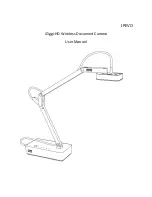
C11440-22C Instruction manual_Ver.1.4
22
10. DESCRIPTION OF VARIOUS FUNCTIONS
10-1 THEORY OF CMOS IMAGE SENSOR
The pixel of a CMOS image sensor is composed of the photodiode and the amplifier that
converts the charge into voltage. The entering light is converted into charge and converted
into voltage in the pixel. The voltage of each pixel is output by switching the switch one by
one. (Figure 10-1)
The FL-400 scientific CMOS image sensor used in this camera has an on-chip CDS
(correlated double sampling) circuit, which plays an important role in achieving low noise. In
addition, the FL-400 realizes both low noise and high speed readout simultaneously, owing
to a split readout scheme in which the top and bottom halves of the sensor are readout
independently, and the data of each horizontal line is read by 2 lines of column amplifier and
A/D in the top and the bottom in parallel and simultaneously. The readout starts from 2 lines
in the center position and then top half is read from center to top and bottom half is read
from center to bottom in parallel and simultaneously.
Figure 10-1 Structure of the FL-400
















































